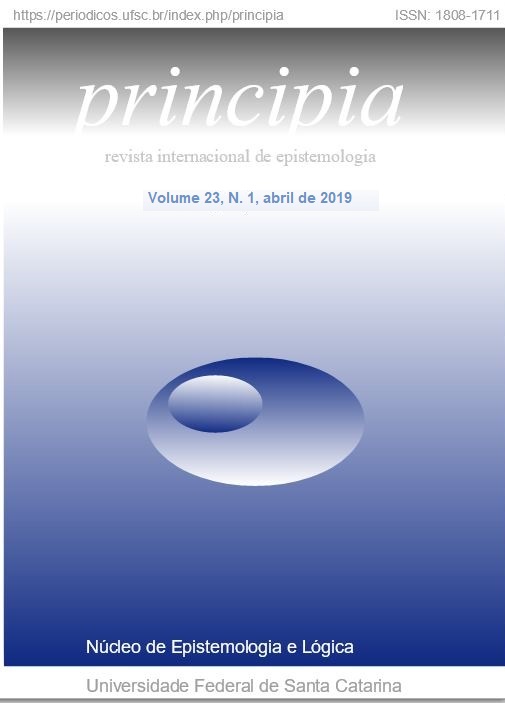Temporal asymmetry and elemental particles
DOI:
https://doi.org/10.5007/1808-1711.2019v23n1p87Abstract
The aim of this article is to argue that a temporal asymmetry may be established within the framework of quantum field theory, independently of any violation of CP, and thereby T, in weak interactions, and independently of the property of time reversal invariance that its dynamical equations instantiate. Particularly, I shall argue that the temporal asymmetry can be stemmed from assessing the links between the proper group of symmetries of the theory and the ontology of the theory: arguments applied to establish which elements and magnitudes remain invariants under group transformations can also be used to establish a temporal asymmetry.
References
Albert, D. Z. (2001). Time and Chance. Cambridge, MA: Harvard University Press.
Arntzenius, F. (2012). “The CPT theorem”, in The Oxford Handbook of Philosophy of Time, eds. Craig Callender, Oxford: Oxford University Press, 634-646.
Bain, J. (2011). “Quantum field theories in classical spacetimes and particles”, Studies in History and Philosophy of Modern Physics, 42: 98-106.
Brading, K. and Castellani, E. (2007). “Symmetries and invariances in classical physics,” pp. 1331-1367 in J. Butterfield and J. Earman (eds.), Philosophy of Physics. Part B. Amsterdam: Elsevier.
Brading, K. and Castellani, E. (2017). "Symmetry and Symmetry Breaking", The Stanford Encyclopedia of Philosophy, Edward N. Zalta (ed.), URL = http://plato.stanford.edu/archives/fall2008/entries/symmetry-breaking/.
Castagnino, M. and Lombardi, O. (2004). “The generic nature of the global and non-entropic arrow of time and the double role of the energy-momentum tensor”, Journal of Physics A (Mathematical and General), 37: 4445-4463.
Castagnino, M. and Lombardi, O. (2005). “A global and non-entropic approach to the problem of the arrow of time”, in A. Reimer (ed.), Spacetime Physics Research Trends. Horizons in World Physics. New York: Nova Science: 74-108.
Castagnino, M. and Lombardi, O. (2009). “The global non-entropic arrow of time: from global geometrical asymmetry to local energy flow”, Synthese, 169: 1-25.
Earman, J. (1989). World enough and space-time. Cambridge, MA: MIT Press.
Friedman, M. (1983). Foundations of space-time theories. Princeton: Princeton University Press.
Greaves, H., (2010). Towards a Geometrical Understanding of the CPT Theorem, The British Journal of Philosophy of Science 61 (1): 27-50.
Horwich, P. (1987). Asymmetries in Time. Cambridge, MA: MIT Press.
Kuhlman, M. and Wayne, A. (2002). Ontological aspects of Quantum Field Theory. Singapore: World Scientific.
Kuhlmann, M. (2010). The Ultimate Constituents of the Material World: In Search of an Ontology for Fundamental Physics. Frankfurt: ontos Verlag.
——— . (2012). “Quantum Field Theory”, The Stanford Encyclopedia of Philosophy, Edward N. Zalta (ed.), URL = http://plato.stanford.edu/archives/win2012/entries/quantum-field-theory/.
McTaggart, J.M.E. (1908). “The Unreality of Time”, Mind, 17: 457–73
Maudlin, T. (2002). “Remarks on the passing of time”, Proceedings of the Aristotelian Society, 102: 237-252.
Maudlin, T. (2007). Metaphysics within physics. New York: Oxford University Press.
North, J. (2009). “Two views on time reversal”. Philosophy of Science, 75: 201-223.
North, J. (2012). “Time in Thermodynamics”, in The Oxford Handbook of Philosophy of Time, eds. Craig Callender, Oxford: Oxford University Press: 312-350.
Penrose, R. (2004). Road to reality. London: Jonathan Cape.
Price, H. (1996). Time´s Arrow and Archimedes’ point: new directions for the physics of time. New York: Oxford University Press.
Price, H. (2012). “The flow of time”, in The Oxford Handbook of Philosophy of Time, eds. Craig Callender, Oxford: Oxford University Press: 276-311.
Sachs, R. (1987). The Physics of Time Reversal. London: University Chicago Press.
Savitt, S. (1996). “The direction of time”, in The British Journal for the Philosophy of Science, vol. 47, No. 3: 347-370.
Sklar, L. (1974). Space, time and spacetime. Berkeley: University of California Press
Wallace, D. (2012). “The arrow of time in physics”, in Adriand Bardon and Heather Dyke (Eds.), A Companion to the Philosophy of Time, Wiley-Blackwell, pp. 262-281.
Weinberg, S. (1987). Elementary Particles and the Laws of Physics, The 1986 Dirac Memorial Lectures. Cambridge: Cambridge University Press.
Wigner, E. (1939). “On unitary representations of the inhomoneneous Loeentz group”, Annals of Mathematics, 40: 149-204.
Downloads
Published
Issue
Section
License

Principia http://www.periodicos.ufsc.br/index.php/principia/index is licenced under a Creative Commons - Atribuição-Uso Não-Comercial-Não a obras derivadas 3.0 Unported.
Base available in www.periodicos.ufsc.br.



